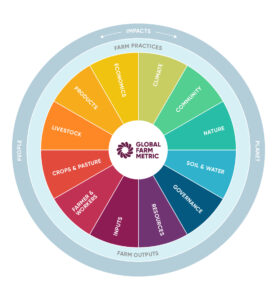Almost half of the world’s habitable land is now farmed for livestock and crop production. The stewardship of this land helps determines our biodiversity, climate and health.
But there are barriers to achieving positive environmental, social and economic outcomes:
- There is lack of a common language that prevents consistent monitoring for sustainability at farm level
- Existing definitions and approaches are often siloed and are not designed to support farmers
- Focus is predominantly on farm practices – as agriculture is context specific, this limits communication between farmers and along the supply chain.
The Global Farm Matric offers a holistic framework that provides a common language for farm sustainability, enabling the transition to better food and farming systems. It is designed to be embedded into farm assessments, audits, certification schemes and management tools to ensure the full scope of holistic sustainability is covered. As well as create a common language, alignment of the data collected will reduce duplication and encourage their use by farmers.

See an example assessment based on the GFM framework here – we are continually developing this with farmers. If you would like to find out more about using the assessment, please contact info@globalfarmmetric.org.
The framework is an open-access resource for all food and farming stakeholders to understand, measure and monitor farm-level sustainability. It enables:
- Farmers to understand the environmental, social and economic state of their farm and identify practices, outputs and impacts they have on the world beyond their farm. Risks to the ability of the farm to sustain itself can then be identified, and farmers can prioritise actions to increase farm resilience. This increases positive impacts, while reducing unintended consequences on the farm and beyond.
- Farmers, food businesses, certifiers, banks and governments to speak the same language and have a shared understanding of what needs to be monitored to build resilient and sustainable food systems. A baseline of farm level data can then be aggregated to track changes at a local, national and international scale. It can also be used as the basis of farm support payments, provide access to new markets and support sustainable investment.A common language can also enable transparency and across the supply chain and has the potential to align food labelling, as well as raise awareness of whole-farm sustainability.
- Citizens would be better able to mobilise their consumer power and make informed decisions.
The GFM is supported by a coalition of over 150 organisations from across the globe. To get involved, contact info@globalfarmmetric.org and sign up to our quarterly newsletter here.
The Global Farm Metric developed by the Sustainable Food Trust is licensed under a Creative Commons Attribution-ShareAlike 4.0 International License.